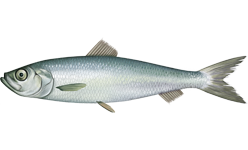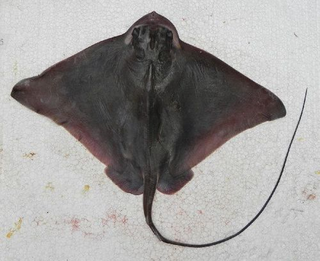
Atlantic herring is a herring in the family Clupeidae. It is one of the most abundant fish species in the world. Atlantic herrings can be found on both sides of the Atlantic Ocean, congregating in large schools. They can grow up to 45 centimetres (18 in) in length and weigh up to 1.1 kilograms (2.4 lb). They feed on copepods, krill and small fish, while their natural predators are seals, whales, cod and other larger fish.

The bigeye sand tiger is an extremely rare species of mackerel shark in the family Odontaspididae, with a possible worldwide distribution. A large, bulky species reaching at least 3.6 m (12 ft) in length, the bigeye sand tiger has a long bulbous snout, large orange eyes without nictitating membranes, and a capacious mouth with the narrow teeth prominently exposed. It can be distinguished from the similar smalltooth sand tiger by its teeth, which have only one lateral cusplet on each side, and by its uniformly dark brown color.

The Pacific sharpnose shark often migrates along the Pacific coast of Mexico. They are most commonly caught in the artisanal fishery of Mazatlán. When a large sample of Pacific sharpnose sharks were observed scientists concluded that this type of shark was a "viviparous shark of small size which is born at an average length of 31 cm." Their gestation period is between ten and eleven months.

The northern wolffish, also known as the blue sea cat or jelly cat, is a species of marine ray-finned fish belonging to the family Anarhichadidae, the wolf fishes. This species is found in the North Atlantic Ocean and Arctic Ocean.

The cottonmouth jack is a gamefish in the family Carangidae. It was first described in 1860 by Cuban zoologist Felipe Poey in his two-volume work Historia Natural de la Isla de Cuba, or "Natural History of the Island of Cuba". It is also known as the cottonmouth trevally.

The round scad is a species of fish in the Carangidae. It was described in 1829 by the French naturalist and zoologist, Georges Cuvier. Although the round scad is considered a good food fish, it is mostly caught for use as bait.

Liparis fabricii, commonly known as the gelatinous seasnail or gelatinous snailfish, is a benthopelagic species of snailfish from the Arctic Ocean. It has a tadpole-like body with a maximum length of about 20 cm (7.9 in). It is brown to black in coloration with a distinctive dark peritoneum. It preys on small crustaceans and marine worms. It is not commercially important, though it is a valuable food source for predatory fish and seabirds in the Arctic region.
Magnisudis is a genus of barracudinas.

Lestidium atlanticum, the Atlantic barracudina, is a species of fish. It is widely distributed in tropical and subtropical waters of the three major oceans. This species reaches a length of 25 cm (9.8 in).

The Southern eagle ray, sometimes known as the Southern eagle fish or the rockfish, is a ray species in the family Myliobatidae. It lives in waters just off of the Atlantic coast, from the tip of Florida down to Argentina, inhabiting estuaries or bays to give birth during spring and summer and migrating to the open sea in autumn and winter. It has an average width of 99 centimeters, and a length of 60 centimeters. It is often confused with the bullnose ray, a related species in the genus Myliobatis, due to the two species' similarities in appearance.

Brotula barbata, commonly known as the bearded brotula, Atlantic bearded brotula, or sugarfish, is a species of cusk-eel in the genus Brotula. It lives in the Atlantic Ocean, in depths of up to 300 meters. Its coloring ranges from olive-brown to red-brown, and it grows up to be around 50 centimeters. It has a carnivorous diet, and it is oviparous.
Gurgesiella atlantica, commonly known as the Atlantic pygmy skate, Atlantic finless skate, or simply the Atlantic skate, is a skate species in the family Gurgesiellidae. It lives in the western central and southwest Atlantic Ocean, from Nicaragua to Brazil. It grows to 49 centimetres (19 in) – 52 centimetres (20 in) long and is distinguished from other skates by its long, slender tail and absence of dorsal fins.
The southern chimaera is a chimaera species in the family Chimaeridae. It lives in Australia, usually in marine waters 780 to 1095 meters deep. It can grow to a maximum length of at least 100 centimeters, and is sometimes confused with Chimaera obscura, a similar species in its genus.
The longspine chimaera is a chimaera species in the family Chimaeridae. It is found off of the eastern and western coasts of Australia, and lives in tropical and temperate waters 435–1,300 meters deep. Males and females grow to a maximum total length of 93.9 and 103.4 centimeters, respectively, and are brown in color.

The headlight fish is a species of lanternfish in the family Myctophidae. It is also sometimes referred to as the headlight lanternfish, or even the lanternfish, though it is not the only species to be called this.
Stemonosudis gracilis is a species of barracudina found in tropical waters of the Atlantic, Indian, and western Pacific Oceans.
Stemonosudis intermedia is a species of barracudina found in tropical and subtropical waters of the Atlantic Ocean from the US to southern Brazil.
Uncisudis longirostra is a species of barracudina. It is found in the eastern-central Atlantic Ocean.
Uncisudis quadrimaculata is a species of barracudina. It is found in the Atlantic Ocean.












